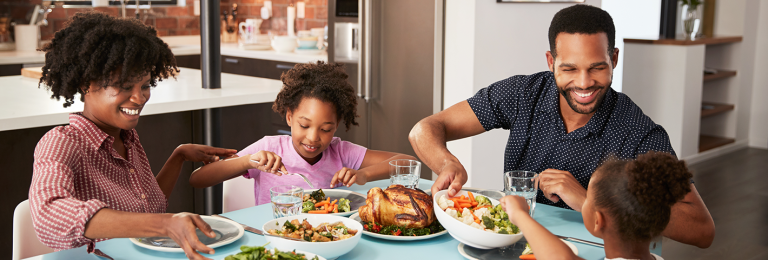Steering the Table Talks at snack and mealtimes
How do children learn their eating behaviours?
Babies and young children learn how to feed themselves by doing. They first observe how their caregivers eat, and then they try copying people around them. This learning is not like a classroom experience with a lesson plan; rather, it happens continuously, often without caregivers' deliberate effort. This sets the foundation for children's lifelong relationship with food and eating.
A caregiver's eating behaviour, modeled in front of children, along with the conversations they have with each other and with the children, sets an eating environment for the children’s relationship with food. By the time children start daycare or kindergarten, they come with their learned eating attitudes and behaviours from their families. This is much like children arriving at your care facility with a preference for their home language. If a child is used to labeling food as "good food" versus "bad food" they are likely to bring this same eating approach to daycare.
What is your role in steering table talks at snack and mealtimes?
When children comment on other children’s eating behaviour or food choices, it can often be perceived as criticism or teasing to make them feel ashamed of their food and ways of eating. As the adult in charge, what can you do? It's crucial to remember that as caregivers, our role is not to correct children’s learning from their family. We need to support and enhance the relationship children have with the adults in their lives, unless the child is in imminent harm. However, we do have an obligation to guide children’s interactions with one another and provide a positive eating environment. This focus is on social interaction, which is different than teaching nutrition. One good approach is to gently redirect the conversation, focusing on the joy of eating, away from labeling food and eating behaviour. We should also model the joy of eating in our own behaviour and language, keeping in mind that this is an interactive and experiential learning process.
For instance, when children bring food from home, you may observe the following interaction among the children at mealtime: “You are going to eat that? That has a lot of sugar, and you will get fat.” You can gently redirect the conversation by saying: “That looks like a doughnut. How does it taste?” When you have a chance, you might want to approach the parents or family and ask them if they'd be interested in sharing this food with the class on a special occasion.
By doing so, you are demonstrating that all food fits, and how we eat is just as important as what we eat. It is tempting to correct and teach a nutrition lesson; however, it's important to refrain from doing so as this is outside of our scope of practice. Our job is to facilitate an eating environment where children learn how to socialize with each other during mealtimes.
Source: Jennifer Schneidereit-Hsu, RD, UBC MPH practicum student (summer, 2023)
